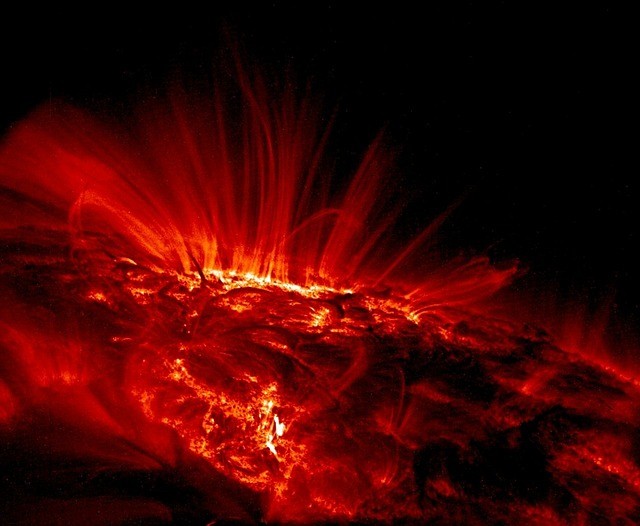In a remarkable find, astronomers led by Sijie Yu of the New Jersey Institute of Technology discovered unprecedented, long-lasting aurora-like radio emissions above a growing sunspot. These signals, reminiscent of Earth's Northern Lights, occurred about 25,000 miles (40,000 kilometers) above the Sun's surface.
The observation not only sheds light on the dynamics of solar radio bursts but also offers insights into large starspots beyond the Solar System. The team from the New Jersey Institute of Technology's Center for Solar-Terrestrial Research (NJIT-CSTR) made this groundbreaking observation.

Sunspot Unleashes Prolonged Aurora-like Emission in Unprecedented Solar Phenomenon
Difference Between the Auroras on Earth and the Sun
Auroras, the mesmerizing light displays seen in Earth's skies, result from solar particles caught in magnetic field lines. These lines act as accelerators, intensifying the particles' energy before depositing them in an atmosphere, creating a luminous glow. While visible light is a component of auroras, there's also a radio aspect.
The Sun, known for various radio emissions, exhibited a profile similar to radio aurorae above a sunspot, temporary darker regions on the solar surface caused by powerful magnetic fields constraining solar plasma.
The team, led by Sijie Yu, suggests this sunspot phenomenon is due to electron-cyclotron maser (ECM) emissions. High-energy electrons, trapped within converging magnetic fields in intensely magnetic sunspot areas, create a unique aurora-like emission.
Unlike Earth's auroras, these emissions occur at frequencies from hundreds of thousands to around one million kHz, reflecting the sunspot's magnetic field strength, thousands of times greater than Earth's. The timing of these radio bursts is not linked to solar flares but appears connected to energetic electrons from nearby active regions.
The rotation of sunspot auroras aligns with solar rotation, creating a "cosmic lighthouse effect." As the sunspot traverses the solar disk, it generates a rotating beam of radio light, akin to modulated radio auroras observed from rotating stars. This groundbreaking discovery prompts further analysis to determine if previously recorded solar bursts exhibit instances of this newly identified emission.
Insights into Solar and Stellar Magnetism
Stars emitting auroral radio signals are not an uncommon phenomenon, as evidenced by a prior discovery of such emissions associated with a closely orbiting exoplanet. Unlike the Solar System's planets, which are too distant from the Sun to induce a similar effect, Earth's proximity allows us to detect subtle aurora-type emissions that might go unnoticed around more distant stars.
The team postulates that flare activity in neighboring regions injects energetic electrons into magnetic field loops connected to the sunspot, giving rise to what they term "sunspot radio aurora." This intriguing observation not only enhances the understanding of the Sun's magnetic dynamics but also establishes links between solar behavior and magnetic phenomena in distant star systems.
Solar physicist Surajit Mondal underscores the importance of unraveling the interaction between energetic particles and magnetic fields in systems featuring persistent starspots, setting the stage for a reevaluation of existing models of stellar magnetism, both on the Sun and on stars far beyond its cosmic neighborhood.
As the team delves into archival data, their ongoing exploration holds the promise of reshaping our comprehension of the intricate relationship between energetic particles, magnetic fields, and enduring starspots in diverse stellar environments.
The team published their findings in the journal Nature Astronomy. It is a collaborative effort that contributes to the evolving narrative of cosmic phenomena and opens new avenues for understanding the broader implications of these interactions across the cosmos.
RELATED ARTICLE: Spectacular Northern Lights Show Anticipated in Northern US, Following Sun's Magnetic Activity Surge
Check out more news and information on the Sun in Science Times.














